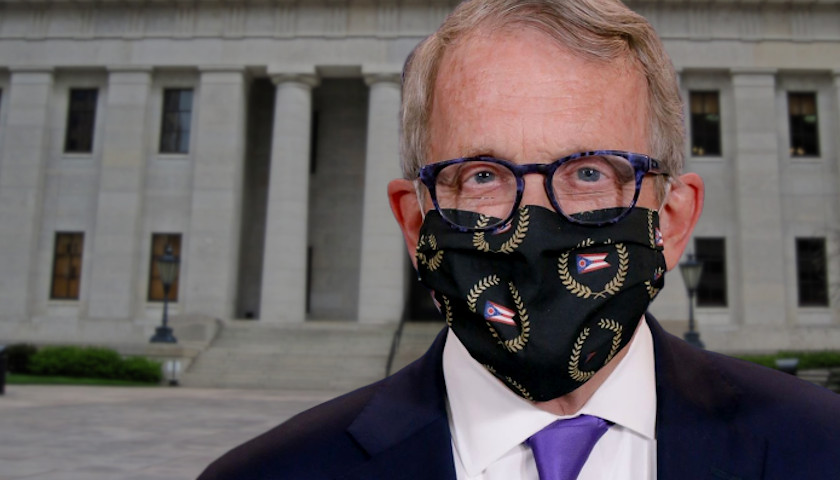COLUMBUS, Ohio – Governor Mike DeWine made time during Wednesday night’s special broadcast to laud Pfizer and their progress on a coronavirus vaccine before effectively re-instating a mandatory mask mandate across the state.
“On Monday, our country received some very promising news regarding a Coronavirus vaccine that Pfizer is developing. The first results from phase three, the final research phase on their vaccine, show it to be very effective in preventing COVID 19. That’s great news. This should give us all great hope,” said DeWine. He continued “it could be here as early as December. And we will be ready.”
The rest of the address covered what the state plans to do before Ohio receives vaccine doses and reaches the governor’s desired level of immunity from significant vaccination uptake.
Back in March, DeWine declared a state of emergency in Ohio and on Wednesday night he made it clear Ohio is still under an emergency and intends to extend the order – “today, I was asked by our hospital leaders to confirm that Ohio remains in a state of emergency. I’m telling you tonight it most certainly does.”
On Monday, during a specially-called press conference with doctors who lead Ohio’s three healthcare zones, Dr. Robert Wyllie of the Cleveland Clinic, Dr. Andrew Thomas of Ohio State University Medical Center and Dr. Richard Lofgren of UH Health all weighed-in on the increase in COVID patients throughout Ohio’s hospitals. They warned that short-staffed facilities may be at risk.
DeWine echoed that thought on Wednesday night, “If we don’t change this, we will not be able to provide appropriate care for all the Ohioans who need it. All the Ohioans who need it for COVID and for all those Ohioans who require other emergency care – things such as accidents, strokes, and heart attacks. Hospitals will gain be forced to postpone important but less urgent care.”
The governor said, if cases continue to rise, bars restaurants and fitness centers would have to be shut down. This came after weeks of praise during pressers for the job restaurants and bars were doing and the claim that spread was not occurring in formal settings such as businesses.
DeWine said he would look at the numbers next week to determine a course of action. However, at a different point in the speech, DeWine said, “we’ve learned throughout this pandemic that what happens today sometimes won’t reveal its true impact for weeks. This is certainly true of hospitalizations and sadly it’s also true of deaths – leaving us with the stark reality that we simply won’t know the ultimate fate of individuals who are diagnosed today with COVID for weeks – or even months.”
Restaurants, bars and fitness centers aren’t the only businesses that will be scrutinized. A revised mask order will put compliance pressure on retail businesses.
“Most retail businesses have done a good job providing a safe place for their employees to work and for their customers to shop. However, it is clear that there are some businesses where mask wearing is simply lacking. We know that masks work. They are the easiest, most cost-effective way to limit the spread of COVID-19. Every retail employee has the right to work in an environment that is as safe as can be, which means all customers must wear masks. Further, each Ohioan who goes out to shop, wherever they go, they have the right to know that every store they enter, every door they go into to shop, will be safe and the people they encounter in that store will all be wearing a mask.”
The revised mask order will contain three additional provisions:
- Each business will be required to post a face covering requirement sign at all public entrances to the store;
- Each store will be responsible for ensuring that customers and employees are wearing masks;
- A new retail compliance unit comprised of agents led by the Bureau of Workers Compensation (BWC) will be commissioned – they will be inspecting to ensure compliance of that mask order.
No statements were made regarding a third offense, nor did the cost to fund the retail compliance unit.
Consequently, The Ohio Star reached out to the governor’s Press Secretary Dan Tierney and asked when the new mask order would take effect, whether it would contain exemptions that are in the July 23 order and for people who have already recovered from COVID. The Star also asked who would be funding the retail compliance unit and how much it will cost.
Tierney said that the order is still being drafted and will be finalized and made effective in the coming days. He also confirmed that the BWC will fund the mask enforcement but did not reply with how much it will cost Ohioans.
A new social gathering order is also in the works. The limit on gatherings to 10 or fewer will remain for both public and private events with congregate areas no longer open. Everyone must wear a mask unless eating or drinking. Dancing and games are also prohibited.
Regarding schools, DeWine urged masking and mitigation measures, saying, “We must do everything in our power to slow this virus down so our kids can stay in school. It is up to each and every one of us. What you do in the community – what we all do in the community – impacts whether our kids will be able to stay in school. No matter how good the schools are, they cannot overcome widespread COVID in the community – it will get into the schools.”
“My fellow Ohioans, few times in our lives will we ever be able to do something, or refrain from doing something, that will or can save a life. This is one of those rare times,” he added.
Prior to the Wednesday night briefing, the state pointed to personal gatherings as the super-spreading events and DeWine continued to plea for Ohioans to restrict their personal behavior, saying, “Please, please don’t host that birthday party or that baby shower, or that kids’ sleepover or that get together to watch the football game. Don’t attend the gatherings that you’re invited to – stay home when you can. Work from home if you can. And as we approach the upcoming Thanksgiving Day Holiday that when someone you don’t live with in your household enters your bubble, it puts everyone you live with at risk.”
Additional pleas from the governor came through an attempt to appeal to religious beliefs. “All the world’s great religions have their version of what we learned as children as the golden rule – treat others as we wish to be treated. Now, whether you were raised in a religious household or not, and whether you adhere to religious teaching or not, all of our most revered teachings are based really on the principle of believing in and working for something bigger than ourselves. It’s a common good. It’s the love for our fellow man – it’s our obligation for our fellow man. And there’s no higher purpose than to work for that common good. Each of us has a moral obligation to do our part and I believe each one of us will do this,” said DeWine.
Yet the message on mask compliance has been mixed – at one time DeWine was praising Ohioans for complying at a level of 80% to 90% but has since indicated that the increase in cases and hospitalizations is due to non-compliance.
Yesterday The Star received communication from the Ohio Department of Health on the topic of mitigation measures and the spread of other respiratory illnesses. In an email, Press Secretary Melanie Amato wrote:
There is currently no evidence that other respiratory illnesses are increasing in Ohio. In fact, there are many fewer non-COVID respiratory illnesses than usual because of the social distancing, mask wearing, and working from home
The Star followed up with Amato to find out why mitigation measures were working for other illnesses but not COVID and if the state, in fact, has evidence to support any claims regarding the level of masking, distancing and other mitigation measures throughout Ohio.
Amato responded:
COVID-19 is much more transmissible than the usual respiratory illness we generally see in Ohio. This fact has been well established in the scientific literature. Additional information on the differences between COVID-19 and influenza can be found on the CDC website here.
As we all know, respiratory illnesses are more common in the winter months. There are many reasons for this including the fact that people spend more time inside, the air is drier which helps the virus get through mucous membranes, and the viruses themselves tend to survive longer in colder temperatures. COVID-19 is very contagious. In fact, it is so contagious that we had outbreaks in the summer months which is highly unusual for a respiratory virus. Flu season is also just beginning as it usually starts in October.
Because mask wearing and social distancing help to prevent the transmission of respiratory viruses, it helps reduce the ability for the virus to transmit in the population. Wearing masks is more effective against the more common respiratory illness like flu because they are already less transmissible.
There is plenty of evidence that the mitigation efforts for COVID-19 have decreased the spread of other respiratory viruses in the southern hemisphere during the winter months when it was summer here in the northern hemisphere. Here is some information from CDC on this topic: https://www.cdc.gov/mmwr/volumes/69/wr/mm6937a6.htm.
The impact of these mitigation efforts have stronger effects on less transmissible disease. To slow the spread of COVID-19, we need more people to consistently wear masks, avoid crowds, and socially distance than you would need to prevent the spread of other respiratory viruses.”
_ _ _
Jack Windsor is Managing Editor at both The Ohio Star and The Michigan Star. Windsor is also an Investigative Reporter at WMFD-TV and The Virginia Star. Follow Jack on Twitter. Email tips to [email protected].





